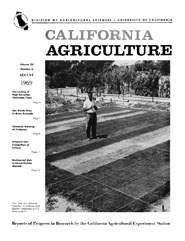


University of California
California Agriculture
|
|||
|
|||

Cover:
Test plots for chemical “mowing” of turfgrass with fluorine compounds ut U.C. Davis.
August 1969
Volume 23, Number 8 |
|||
|
University of California, 1301 S. 46th St., Bldg. 478 Richmond, CA
|